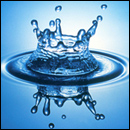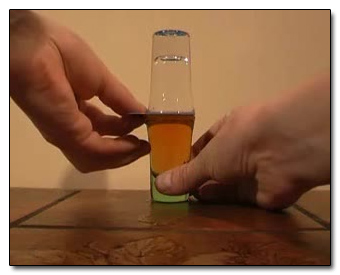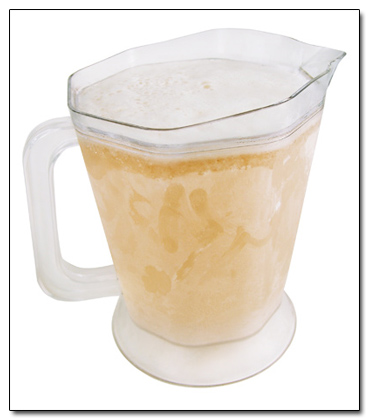5 Scientific Ways To Make Water Do Magic

Science has proven that much of the universe is made up of badassery. You can find it all around you, including in something as simple as water. You just need to know the tricks to unleash it.
So here are some badass things you can do with water that seem to cross the line between science and magic. And best of all, they're all completely safe!
Water Can Explode, With No Explosives

OK, this one is incredibly dangerous.
This involves "superheating" water, by getting it way beyond the boiling point without having it actually boil. It's easier than you think, since actual boiling, that is bubbles escaping hot water, can only be achieved with a "seed" (say a point, preferably sharp, where bubbles can form). Normally, minerals in the water and imperfections in the surface of the container are more than enough for this to happen.

However, distilled water has no such minerals, and if you put it in a relatively smooth container and stick it in the microwave, the water can be heated beyond the normal boiling point and will remain perfectly still.
Then, you toss in an object in and watch it explode:
You're watching the boiling process happen all at once, in a fraction of a second, in a way that will result in boiling water flying back into your face. Do we need to tell you that if you must try this at home, to only do it with adult supervision and proper safety equipment? Do we really?

Because we have a feeling that no matter what we say, some of your are going to try this, and that at least one of you, for some reason, will do it nude.
Water Can Climb Walls and make Bridges

Yeah, this one is also pretty dangerous. We're off to a terrible start here.
Remember that creature from The Abyss that was made of sentient, free-moving water? Well you can create a little version of that thing, and all you need is two adjacent containers of water and a bunch of electricity.
While this may sound far fetched, its actually quite simple. You see, to get the water from the cathode beaker to the anode beaker... actually, it's completely bizarre and we think the guys who discovered this aren't really sure why it works either. It seems to have something to do with electrical fields and the "unique structure of water."

But it does work, and apparently requires some mellow music in the background:
A guy with the chick-magnet name Elmar Fuchs, from the Graz University of Technology in Austria, discovered the phenomena. This was presumably while bored and playing with electricity and water, right down the hall from the "Fork and Light Socket" testing room. They found that he could create a free-standing bridge of water that could be stretched to a whopping 25 millimeters--not quite an inch (so don't be expecting water bridges to be the new rage in sky-walks any time soon).
Since electricity and water generally don't mix, in addition to the two beakers and water you may also need some balls as big as a bull elephant's. Or the brain of a garden slug. Either way we figure it's just a few years until scientists can make a water sculpture of Ed Harris.

The Water and Whiskey Anti-Gravity Switcheroo

Speaking of learning the magic of science via alcohol, here's the kind of trick they teach in Bartender School.
This one happens with the help of the only liquid in the known universe with more magical properties than water: whiskey. Pour a shot glass full of whiskey, and another full of water. Slap a playing card over the water, and turn it over on top of the whiskey, like so.

Pull the card aside slightly, and the water and whiskey, instead of mixing, will neatly switch places
This does require some patience though, since the whole thing can take 10 minutes or more.

It works because whiskey is 40 percent alcohol, which is less dense than water. When the water glass is inverted and the card is moved to allow a tiny gap, the water trickles through, unseen. The whiskey, being lighter, is forced out of the lower glass into the upper. Scientists compare it to the jocks kicking the nerds out of the dorm in Revenge of the Nerds.
Make Instant Snow From Boiling Water

This one requires it to be really, really freaking cold outside. Like way colder than it probably gets where you live. But get a day way below zero, boil a cup of water, and toss it into the air. The results are as cool as shit:
If it gets to be 30 degrees Fahrenheit or so below zero, the water vapor will freeze instantly. That's why the water has to be boiling, as the vapor has a much higher surface-to-mass ratio (the same reason you will freeze to death slower than say, a mouse).

All of those little heated particles of water cool very rapidly when exposed to super cold air, forming ice crystals in an instant. BUT ONLY IF IT IS COLD ENOUGH.
We do the all caps there because once again we fear somebody going out on what's considered a cold day in California (say, 60 degrees) and tossing a pot of boiling water toward their friends. And then suing us.
Instant Ice

Here is a trick that works on the same principle but doesn't require you to live in Minnesota. And the results are actually just as bizarre.
You may have even seen this principle in action before, if you have ever felt the gut-wrenching sadness associated with putting a beer in the freezer to cool it down quickly, only to forget it for three hours. It looks fine when you pull it out, but when you open it you find flat-beer flavored slush has instantly formed inside.

Now imagine how pissed we'd be if it wasn't just a shitty Heineken Light.
The deal is that super-cooled water works just like superheated; unless there is a "seed," no ice crystals will form, so the water stays liquid beyond the normal freezing point. With water, the "seed" can be introduced just by tapping the side of the container (or in the case of the beer, creating the delicious bubbles). Behold as the water freezes solid in seconds, like you're the damned Iceman from X-Men:
This actually works better with beer, especially Corona (because it comes in a clear bottle, so is easier to see). Put the bottle in the freezer either in the morning or overnight. Once it has been in there for hours, all you have to do is open it. As soon as the bubbles begin to form, the water in the beer will immediately crystallize. Break the bottle and you'll have a delicious beercicle that will last for hours!

You can find more from David at Associated Content.
For mores more information that will come in handy during Tuesday night trivia, check out 7 Species That Get High More Than We Do and 5 Ways Your Brain Is Messing With Your Head.
And visit Cracked.com's Top Picks before we show you a cool water trick that involves cement shoes.